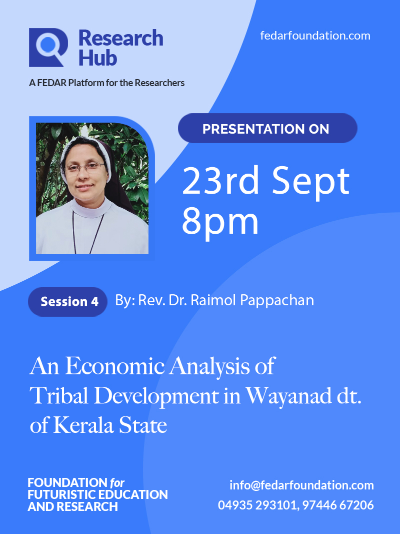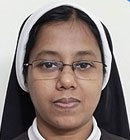An Economic Analysis of Tribal Development in Wayanad District of Kerala State

Thesis paper by : Rev. Dr. Raimol Pappachan
Presented on : 23-09-2021
Summary
AN ECONOMIC ANALYSIS OF TRIBAL DEVELOPMENT IN WAYANAD DISTRICT, KERALA
The general objective of the study is to explore the contemporary economic status of major tribes like Paniya, Kurichya, and Kattunaikka of Mananthavady Taluk of Wayanad District of Kerala. This study also discussed about the awareness and attitude of tribes towards various tribal development programmes, the pattern and inequalities of income, expenditure and asset holdings among the tribals in the study area and the status of standard of living and level of poverty among the selected tribal communities of Wayanad. The economic analysis of the tribal communities in Mananthavady taluk of Wayanad district was made by collecting primary data from 598 tribal households belonging to Paniya, Kurichiya and Kattuniakka tribes from the panchayats of Panamaram, Thavinjal, Thirunelly and Vellamunda and the municipality of Mananthavady.
The analysis revealed that the Kurichiya tribal households are far better off than the Paniya and Kattunaikka tribal households about the level of awareness of tribal development programmes. Comparative analysis of the tribal communities’ by Lorenze curve shows that the income inequality of Kurichiya tribe is higher than the Paniya and Kattunaikka tribes. Similarly high degree of expenditure inequality prevails among Kurichiya and Kattunaikka tribes but the degree of inequality among Paniya tribe is low.
Standard of Living Index (SLI) is an index constructed to understand the general living conditions of tribes of Wayanad viz. Paniya, Kurichiya and Kattunaikka. SLI has been assessed by taking in to account of different parameters on living standards. Type of house and ownership, availability and type of toilets, drainage facility, accessibility to safe drinking water, availability of water pumps, energy used for lighting, educational status, possession of land, physical assets and consumer durables, level of income, saving and availability of medical facility etc. are used for the measurement of Standard of Living Index. Among the three tribes, the low level standards of living have been found in the cases of Paniya and Kattunaikka with the huge percentages of 88 and 74.6 respectively. Kurichiya tribe is comparatively better than these two tribes. The Global Multidimensional Poverty Index (MPI) measures severe deprivation among the households with respect to education, health and living standards. The study of Multi-Dimensional Poverty Index of the sampled tribal households exposed the fact that among Paniyas 90 per cent belongs to very poor category, 9 per cent are vulnerable to poverty and less than 1 per cent have a comfortable life. Kattunaikka community is not very much significant from Paniyas and their categorization showed that 84 per cent falls into the category of very poor, 11 per cent in the category of vulnerable to poverty and a meagre 5 per cent is in comfortable life. On the other hand 73 per cent of Kuruchiya are in comfortable, 18 per cent of households are prone to vulnerability and a low 10 per cent of the households are under poverty.
The major implication of this study is that the government and NGOs must take concerted efforts to propagate the awareness about developmental programmes among the tribals so that most of them can be benefitted which will pave the way for the improvement of economic status and standard of living. As the economic as well as the social conditions of the tribal communities differ considerably in different regions, a blanket scheme for all tribal people may not be successful. Instead of that tribe specific programmes related to local resources and conditions needed to be drawn up for the purpose of development. Tribal development shall not be conceived in terms of economic development alone, it should be looked upon as an organised activity with the aim of satisfying certain basic needs and psychologically orient the tribals to adopt new skills, attitudes and lifestyles. So that they build-up the inner strength and appropriate social and cultural infrastructure to stand the pressures of new situation and accrue benefits from new programmes and maintain higher levels.






 Corehub Solutions Pvt. Ltd
Corehub Solutions Pvt. Ltd